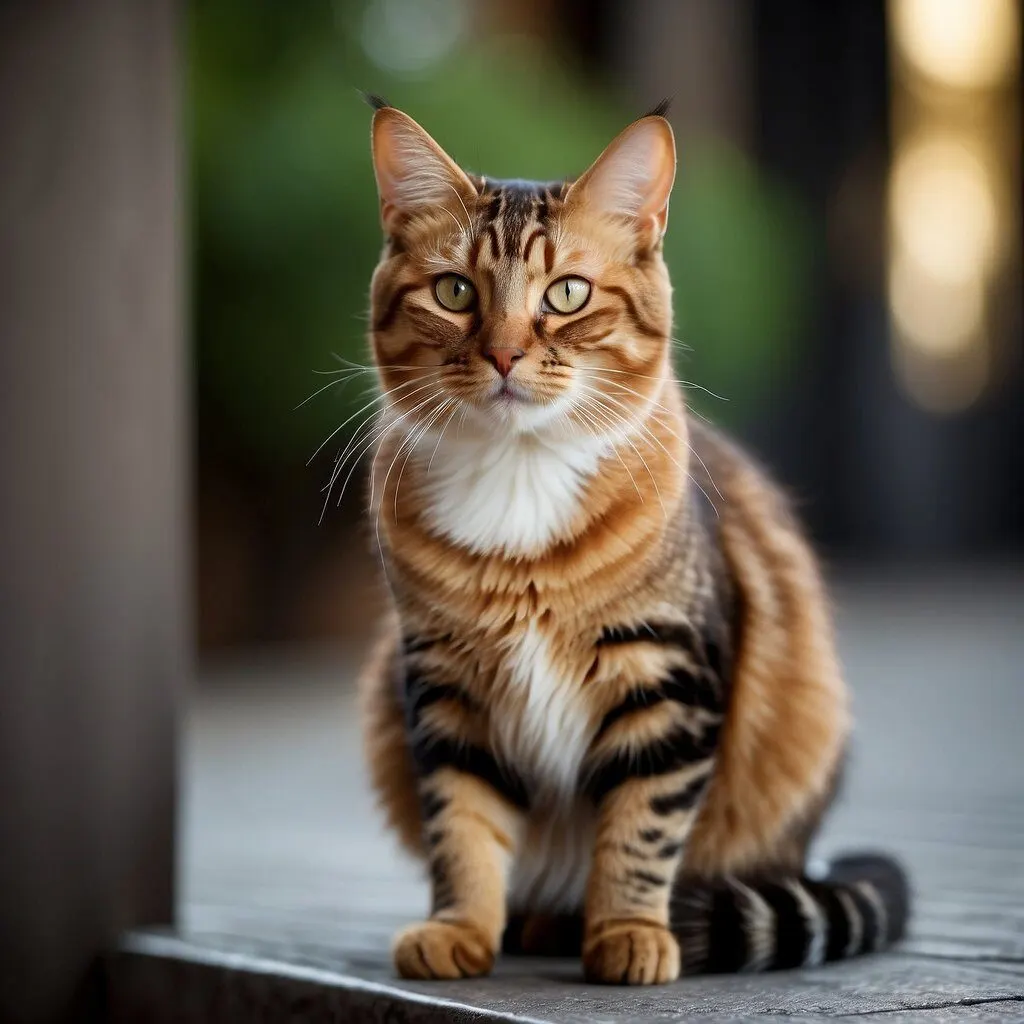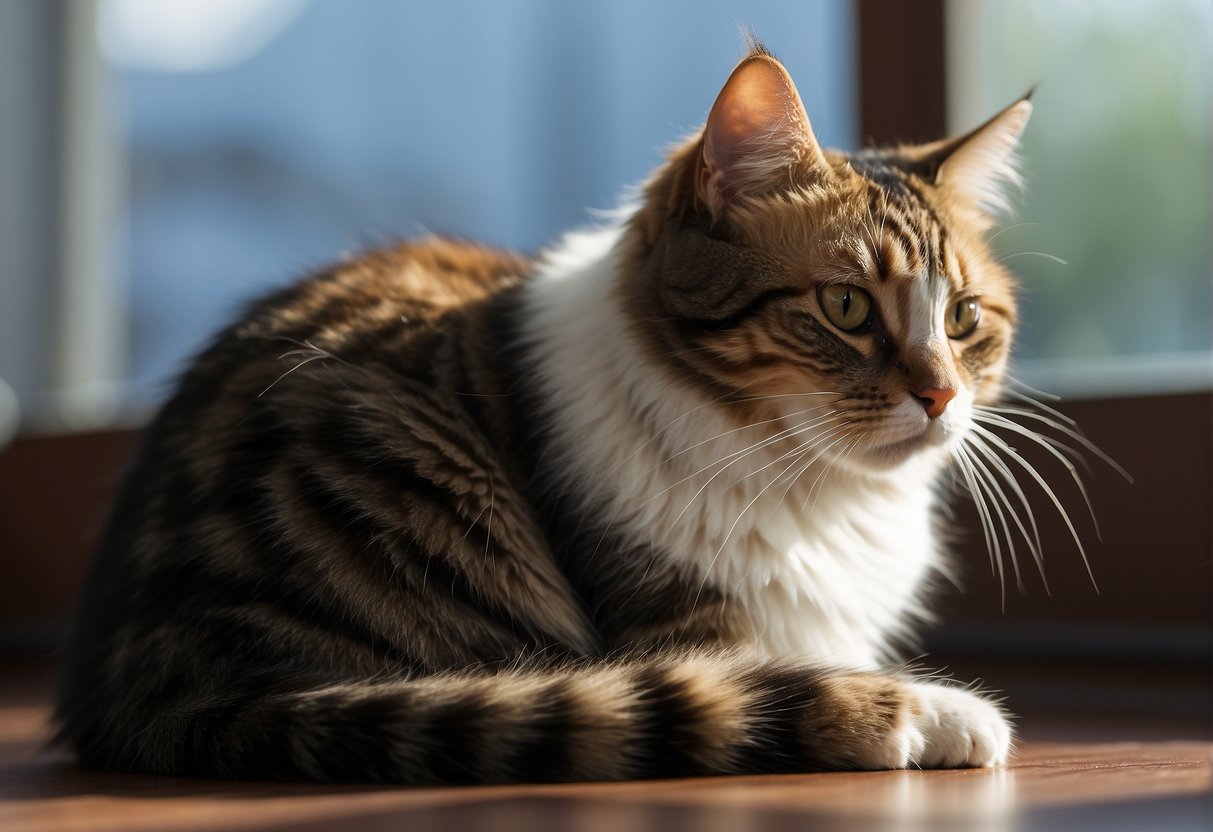When your cat starts to develop bald spots, it can be both puzzling and concerning.
Hair loss in cats, medically known as alopecia, can occur for various reasons, including allergies, stress, parasites, or even underlying health issues.
For instance, I noticed once that over-grooming due to a flea problem led to hair loss in certain areas in my cat. Seeing patches like that can be scary, so as you can imagine, I researched everything I could so he could get back to growing out his full coat of hair.
It’s important to observe if the balding patches are accompanied by any changes in skin appearance, such as redness or irritation, which can signal inflammation.

In another case, you might find that your cat has symmetrical hair loss, which could be a sign of hormonal imbalances or, less commonly, genetic conditions.
Even the best-kept indoor cats can experience stress or encounter allergens that lead to excessive licking and hair loss, just like my own did during a particularly noisy home renovation.
Baldness in your feline friend doesn’t necessarily mean a serious condition is at play, but it does mean that your cat could be uncomfortable and in need of some attention.
Proper nutrition, regular parasite control, and a comfortable environment can help prevent some forms of hair loss, but it’s always wise to consult with a vet to get to the root of the problem, especially if the hair loss is sudden, widespread, or accompanied by other symptoms.
Your vet can perform tests to determine the exact cause and recommend the appropriate treatment to get your cat’s coat back to its fluffy state.
Cat Hair Loss Explained
When your cat begins to show patches of missing fur, it’s natural for you to be concerned.
Common Causes of Hair Loss in Cats
Hair loss in cats, medically known as alopecia, can stem from a variety of causes. Let’s examine a few:
- Parasites: Fleas, mites, and lice can cause your cat to scratch excessively, leading to hair loss.
- Allergies: Sensitivities to food or environmental factors can trigger skin reactions and hair loss.
- Infections: Fungal infections like ringworm can result in bald spots.
- Hormonal Imbalances: Conditions like hyperthyroidism may cause hair thinning and loss.
- Skin Conditions: Issues with the skin such as dermatitis can make hair fall out.

Recognizing the Signs of Alopecia
Identifying alopecia in your cat involves looking for certain signs:
- Bald Patches: Sudden hair loss leaving exposed skin.
- Excessive Shedding: More hair than usual on your furniture or clothing.
- Over-grooming: Licking or pulling at fur more than what’s typical.
It’s important to observe the skin under the lost fur:
- Inflamed Red Skin: Might suggest an allergic reaction or irritation.
- Normal-Looking Skin: Could be a sign of behavioral issues.
The Role of Stress and Behavior
Your cat’s emotional state can significantly influence their coat’s condition:
- Stress Induced Alopecia: Anxious or stressed cats may over-groom as a coping mechanism.
- Boredom or Anxiety: A lack of stimulation or changes in the environment can lead to excessive licking and balding.
Medical Conditions and Allergies
Hair loss in your cat can be an alarming sign, often pointing towards underlying medical conditions or allergies. It’s important to consider factors like skin infections, parasites, hormonal imbalances, and more serious health concerns when investigating the causes.
Skin Infections and Parasites
Your feline friend’s bald spots may be caused by skin infections like ringworm, which is a fungal infection, or from parasites such as fleas and mites.
These culprits can cause irritation and redness leading to overgrooming and hair loss.
Diagnosing these issues typically involves a fungal culture or cytology to identify bacterial or fungal infections.
Treatments could range from antibiotics or antifungals for infections, to specific medications or therapies for parasites, such as mange.
Allergies and Hormonal Imbalance
Cats can develop allergies, which could cause skin disease and subsequent hair loss.
Flea allergies, food allergies, and environmental hypersensitivities are some common triggers.
Signs may include dermatitis and inflammation.
Hormonal issues like hyperthyroidism and Cushing’s disease also lead to changes in your cat’s coat health.
A vet might suggest adjustments in diet or prescribe medication to manage these conditions.

Serious Health Concerns
In some cases, hair loss in cats could be related to more serious health issues, which can include systemic illnesses or even cancer.
Diagnostic Approaches
When you notice your furry friend starting to lose hair, it’s crucial to understand the steps your veterinarian will take to diagnose the reason behind the bald patches. Let’s explore how your vet may approach this and what treatment options are available to manage the condition.
Veterinary Examination and Testing
Your first step should be booking a visit to a veterinarian.
They’ll start with a thorough examination of your cat’s skin to look for any signs of infection, parasites, or other skin issues.
Often, they’ll use a microscope to examine hair or skin samples. Here’s what you might expect:
- Skin scraping: This helps to find parasites that could be munching on your cat’s skin.
- Culture: To detect any fungal or bacterial infections, a sample might be taken.
- Bloodwork and Urinalysis: These tests can reveal overall health and pinpoint issues like thyroid problems.
- Allergy testing: If the vet suspects environmental allergies, they may suggest this.
- Skin biopsy: If the cause is still a mystery, a small skin sample can reveal more.
Remember, if your cat is also sick, showing signs like vomiting or diarrhea, mention these to your vet as they are important diagnostic clues.
Treatment Options and Management
Once a diagnosis is made, the vet will discuss treatment options with you.
Depending on the cause, your cat’s hair loss can be managed with:
- Topical therapy: Medicated shampoos or ointments to tackle skin conditions.
- Systemic antibiotics: If an infection is the culprit.
- Antihistamines or cyclosporine: These may be used if allergies are to blame.
In some cases, a veterinary dermatologist could become involved, especially if the issue is complex.
They can offer specialized treatments and advice on managing chronic skin issues.
Prevention and Home Care
Before diving into specific strategies, understand that preventing hair loss in cats often involves reducing stress and enhancing nutrition. These two pillars can fortify your cat’s health from the skin to the tips of their fur.
Stress Reduction and Environmental Management
Your cat’s environment has a huge impact on their stress levels. Excessive grooming, scratching, itching, and even biting at their coat can be signs of stress. Here’s how you can help reduce stress:
- Interactive Toys: Engage your cat with various toys to keep them entertained and reduce stress-related behaviors.
- Feliway Diffuser: This emits a synthetic pheromone that can have a calming effect on your cat, similar to the natural pheromones they release when they feel safe.
- Elizabethan Collar: If your cat is constantly biting or scratching at their fur to the point of hair loss, this collar can prevent them from injuring themselves while you address underlying issues.
- New Pet Introductions: If you’ve recently added a new pet to your home, do so gradually to minimize stress.
Nutrition and Supplements
Proper nutrition is key to maintaining healthy skin and coat. Nutritional deficiencies can lead to hair loss, so it’s important your cat receives a well-balanced diet.
This includes:
- Royal Canin: A brand that provides prescription diets for specific health issues. For example, urinary tract problems can cause stress and lead to over-grooming.
- Supplements: Omega fatty acids are known to improve coat health. However, only add supplements to your cat’s diet after consulting with your vet.

My name is James, and welcome to FAQCats!
Along with our team of cat owners, expert pet enthusiasts, and pet professionals, we aim to write engaging helpful, engaging content about cats. At FAQCats we strive to provide content that’s accurate and fun to read. Our team writes about everything related to cats; even the most complex of topics. Through extensive research and caring for our own fur-pals, we’re able to provide something cat owners worldwide will love. Have a look around, and leave us feedback anytime!

